Mesa Verde Horses
mESA VERDE PROJECT ACCOMPLISHMENTS, 2019 TO THE PRESENT
2019 – Following Tim McGaffic’s detailed bait-trapping plan, Tim, a then-NMACO board member, and volunteer Dale Ward assisted the Mesa Verde National Park (the “Park”) with setting up the first bait site in the Park under an agreement between the Park and the NMACO. The process was done gradually to habituate the wild horses to the presence of corral panels and equipment as well as bait in the form of water, salt and hay. Whit Hibbard taught two low-stress stockmanship classes to Park personnel and NMACO volunteers to prepare the team for moving, loading, and unloading horses in confinement.
2020 – The COVID-19 pandemic disrupted the gathering project.
2021 – Marvel, a young bachelor stallion was captured gently after his sire drove him from his band. Marvel’s sire was Maestro, a handsome, alert, and battle-scarred Perlino.
2022 – Tim, Dale, and Park personnel Nathan Brown and Krystal Lamb set up one bait and trap site and gathered 14 adult horses and 5 foals. The lead stallion Maestro and four of his mares were sent to sanctuary. Nine horses were sent to Dr. Irick’s Mustang Camp in New Mexico for gentling and taming in preparation for adoption.
2023 – Eighteen adult horses were humanely captured under a modified process modeled after Tim McGaffic’s original plan. Three older stallions and one older mare were rehomed at a sanctuary. Fourteen horses were transported to trainers in Colorado to tame the horses for adoption. Some mares had foals by their side, and most were pregnant.
2024 – In May and June, Mesa Verde Park personnel began setting up bait-trap stations. The Park planned to capture 35 to 40 mustangs in the 2024 gathering season. A total of 9 horses were captured for removal as of late October. The band of nine included a lead bay stallion, six mares, a yearling colt and a younger colt. NMACO arranged to have the entire band placed at The Wild Horse Refuge’s 23,000-acre wild horse sanctuary in Craig, Colorado. The Park advised that it will resume bait-trapping in Spring 2025.
WILD HORSES OF MESA VERDE
Horses have roamed Mesa Verde for at least two hundred years, long before it was decreed as a national park in 1906 by President Theodore Roosevelt. Presently several bands numbering up to 7 or more live in four or more canyons and on three or more mesas in the Park. Water sources are ever so scarce in the Park.
People began inhabiting the green mesa top in 7500 BC. Ancestral Puebloans began building rock shelters in 750 AD. By 1300 AD, the nomadic family groups of the Ute tribes migrated from the Great Basin into the Four Corners region. Spanish settlers brought horses to the Americas in 1519, when Hernán Cortés arrived in Mexico. Indigenous peoples were accompanied by horses northward along trade networks. Eighty-four scientists determined recently that the Indigenous peoples in the Americas had integrated horses into their societies as early as the mid-1500s. Indigenous peoples spread horses through the American West by the first half of the 1600s. The Ute Peoples acquired the horse around the 1600s and by the 1770s had developed a tradition of horse husbandry and use of the horse for transportation. Horses enabled the Utes to cross distances faster and farther. Horses were used to surveil lands, explore, visit, pack, trade, raid, and plunder. The Ute people had become known as the People of the Horse. Horses would escape confinement and proliferate in the wild. The Old Spanish Trail, a trade route between Santa Fe and California, used by pack trains in the late 1820s, provided new opportunities for trading, looting, and migrating. By the 1870s, gold was discovered in the southwest mountains of Colorado, and the Brunot Treaty of 1873 was negotiated. The treaty resulted in Ute People’s ceding the San Juan and La Plata Mountains to the U.S. government. The Ute reservation then was restricted to a strip along the southwest borders of Colorado, including Mesa Verde country. Mesa Verde, the “Green Table,” had no rivers and no streams. Its high desert and dry plains are carved with canyons that make the topography look like crocodile skin from above. The people, the wildlife, and the free-ranging horses were dependent on springs or seeps for water. As needed, horses would travel on steeply sloped sandstone canyon trails to reach water far below the mesa and miles away.
When Mesa Verde was established as a national park in 1906, the boundaries failed to include the most spectacular of the Ancient Puebloan cliff dwellings. The Assistant Commissioner of Indian Affairs and the Inspector with the Department of Interior negotiated a land exchange with the Weminuche Utes that was signed May 10, 1911. The Mesa Verde National Park was expanded by 3.75 miles southward. That addition was surrounded by the Ute reservation. Wild horses, elk and deer were oblivious to established borders and would roam across boundaries and gain access to Park’s lands.
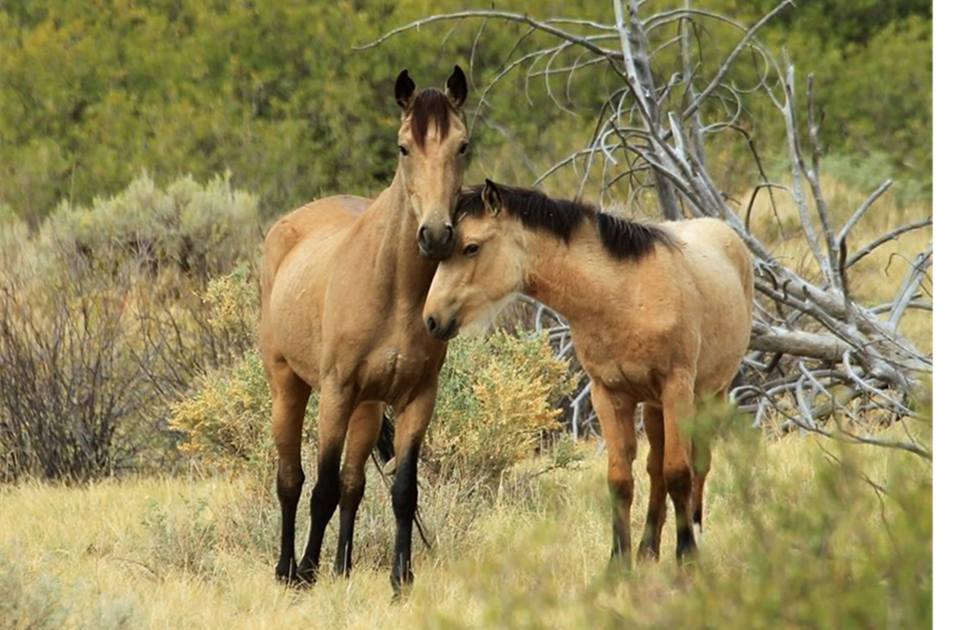
Photo credit: NMACO/TJ Holmes
WILD HORSES BECOME PROHIBITED IN THE PARK
According to the Mesa Verde Park’s administration, horses are not considered indigenous wildlife and federal law does not allow livestock in the park. Additionally, the horses at Mesa Verde do not fall under the protection of the Wild Free-Roaming Horses and Burros Act of 1971 (“the Act”). The Act identifies specific public lands in the United States where wild horses are to be managed by the Bureau of Land Management (“BLM”). The land of the Mesa Verde National Park is not BLM land, which leaves the wild horses in the Park unprotected by the Act. The Park’s position is that the wild horses are trespass animals and their presence is a threat to the Park’s primary purpose, which is the preservation of archaeological sites.
For several years prior to 2013, the NMACO and other wild horse advocates urged the National Park Service at Mesa Verde to allow the management of the horses using an injectable immunocontraceptive vaccine, but the National Park Service had considered the horses to be a nuisance. The Park determined a need to remove the horses. By 2013, a multi-year drought had begun drying up the springs and seeps, triggering an imminent crisis for the wild horses of Mesa Verde.
In an October 2013 article in The Denver Post, the park’s wildlife biologist stated that instead of developing a management plan for the horses, the park would “continue to try to strengthen boundary fences and to use fencing to keep horses away from water sources.” This action was meant to “serve as a sort of management tool: Lack of water will force the horses to go elsewhere, and when horses are under stress from too little food or water, they are less fertile.”
In July 2014, six horses were found dead in Mesa Verde National Park. The horses were thought to have died from dehydration. Protestors insisted that the Park should provide water to wild horses in the Park, but the Park’s authorities affirmed that its mandate was not to manage the wild horses. The Park began evaluating the situation and preparing a horse removal plan. The Park announced it had a removal plan in 2018.
By 2019, the Park had agreed to allow NMACO to partner up and offer its support for habituation and bait trapping as the preferred approach to removing the estimated 80 horses roaming the Park. NMACO agreed to take title to the horses upon capture so that the horses would have the best chance of humane rehoming.
Consistent with NMACO’s mission, volunteer and then-NMACO board member Tim McGaffic provided the Park with a detailed plan for gradual habituation and baiting to gently capture the horses. Additionally, Whit Hibbard, on behalf of NMACO, provided Park personnel and NMACO volunteers with training in using low-stockmanship principles to move and load horses to minimize the stress upon horses during removal and to maximize safety to humans and horses.
From the first horse gathered in 2021, and through 2024, NMACO remains involved as a partner to the Mesa Verde National Park with its removal process. Consistent with NMACO’s mission, the goals are to keep the horses safe and provide them with the least harmful alternatives upon removal.
KEY CONTRIBUTORS
TIM MCGAFFIC
In 2019, Tim prepared a detailed habituation and bait-trapping plan for the Mesa Verde Project that took into account the terrain, climate, and of course, his knowledge of horse behavior.
Tim has been a horse trainer, ranch manager, and consultant to ranches and businesses for over 30 years. He is a certified educator for Holistic Management and a member of the International Society for Equitation Science. He has worked with behavioral specialists around the country to learn how to humanely manage, capture, and train various species, including capturing hundreds of wild horses and cattle in Hawaii. He has conducted clinics and seminars throughout the United States and helped ranches with their animal behavior and logistical issues. See Tim’s website https://thenatureofnatural.com/ for more information.
WHIT HIBBARD
Whit assisted with the low-stress stockmanship training for NMACO volunteers and Park personnel to prepare the team to move, load and unload wild horses most safely and gently. Whit is a fourth-generation Montana cattle rancher, publisher/editor of Stockmanship Journal, and a former National Park Service mounted ranger. He writes a stockmanship series for Drovers and On Pasture, and teaches low-stress livestock handling clinics for bovine and bison producers all over the Western United States, Central Canada, and Mexico. He was the director of a highly successful two-year project to round up trespass livestock from Mexico in Big Bend National Park. Whit walked wild horses into capture at Theodore Roosevelt National Park. He taught low-stress bison handling to the National Park Service, United States Fish and Wildlife Service, Parks Canada, and has provided his expertise to the Turner Ranches.
LYNDA LARSEN
Lynda practiced law in Los Angeles for almost 20 years and maintained her love for horses with jumping, eventing and dressage. In 2012, she retired early and moved to Colorado to join her friend Pati Temple and the Colorado Chapter of NMA in working with wild horses. Lynda has trained and ridden horses over the mountains and in the canyons in the Four Corners area. She believes mustangs can be the best companions. Lynda devoted twelve years to NMACO as a highly dedicated volunteer and board member, wearing many essential hats. Lynda retired from the board in August 2024. Today, she serves as a valuable consultant to the organization.
MONIQUE WYLDE WILLIAMS
Equine ecologist Monique Wylde Williams joined NMACO’s Mesa Verde Project in 2021. She was instrumental in laying the groundwork for NMACO’s gentling, training, and adoption programs; and serves as a consultant and guide to understanding the biology and ecology of the feral equine.
DR. PATRICIA BARLOW-IRICK OF MUSTANG CAMP
Dr. Barlow-Irick provided initial training support for the Mesa Verde Project. Dr. Barlow-Irick operates Mustang Camp, a nonprofit training facility located in Blanco, New Mexico. Her training program involves a methodical 26-step approach when working with wild horses and burros.
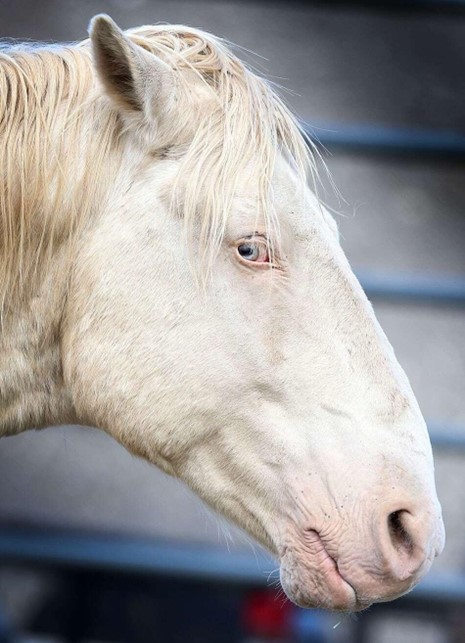
Photo Credit: Jerry McBride/Durango Herald
Vigilant Maestro, the lead stallion from Mesa Verde in 2022 in a holding facility in the Park
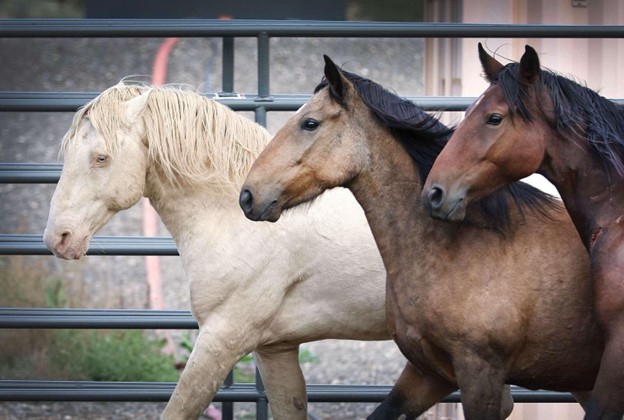
Photo Credit: Jerry McBride/Durango Herald
Three horses in holding at Mesa Verde National Park in 2022.

Horses in a holding pen in Mesa Verde National Park.
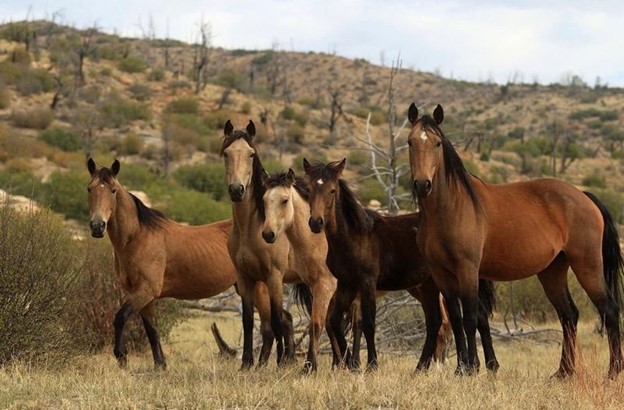
Horses in Mesa Verde National Park
KEY PRINCIPLES OF HORSE HANDLING AND MANAGEMENT
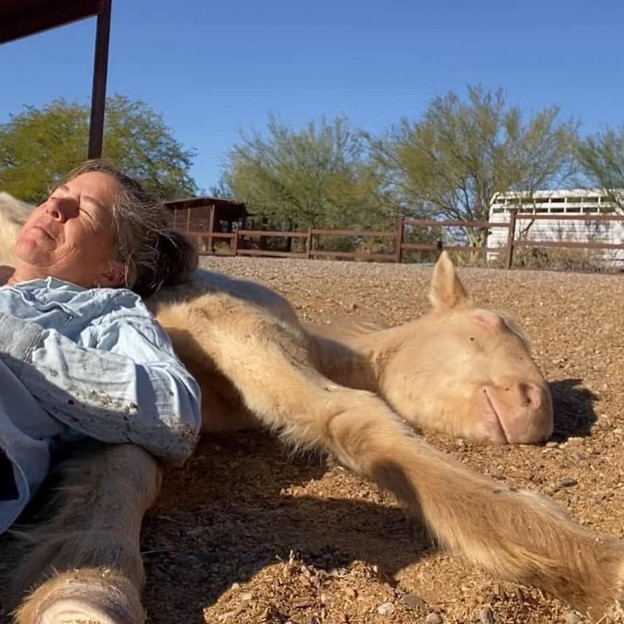
Monique Wylde Williams napping with her Mesa Verde mustang Rune
THE LEAST DISRUPTIVE APPROACH
NMACO’s mission is to preserve and protect horses in the wild and to promote conscious and humane management. To carry out the mission for the wild horses that require intervention and advocacy, NMACO attempts to take the least-disruptive approach possible for the horses, whether they are federally protected under the Wild Free-Roaming Horses and Burros Act of 1971. The options for rehoming horses are to place wild horses in sanctuaries or to adopt the horses into a life of domesticity by qualified adopters under the organization’s adoption and training programs. Either approach comes with costs related to veterinary and other care, including but not limited to the following: sedation darting, gelding, micro-chipping, providing medical intervention, vaccinating, transporting, handling, using equipment and supplies, providing feed, water, and supplements, and covering general administrative and operating expenses. When adopting tamed horses, the handling costs increase per horse, A horse that is gentled and able to be handled safely around humans makes for a much more desirable adoption candidate. NMACO typically does not provide the horses with advanced training such as saddle training. Pregnant mares with foals by their side during the gathering process may add to the time that NMACO must retain custody and care of those horses, as foals require weaning before rehoming.
GENTLING VERSUS TRAINING
To promote conscious and humane management, NMACO’s approach makes a distinction between the process of gentling a wild horse and training a wild horse. According to Monique Wylde Williams, Equine Ecologist, and volunteer to NMACO, people may tend to conflate the gentling process with training, but the two are better seen as distinct processes, whereby the gentling process is done first and not rushed. Gentling a horse acclimates the horse to living among humans and a daily schedule that involves the horse being watered and fed reliably. The horse is allowed time to generate a positive association with living among humans. This habituation process leads to a more relaxed, calm, and curious state of mind that then leads to openness and a willingness to be trained. Only after gentling, then the horse may be trained to don a halter, be led by and asked to stand to have its feet handled, or to be trained for easy loading into a trailer and unloading from a trailer, and so forth.
PRINCIPLES OF HABITUATION AND LOW-STRESS STOCKMANSHIP
Conscious and humane approaches to gathering horses involve a gradual habituation process during the bait-trapping of horses. Conscious and humane approaches to moving horses in confinement and for loading and unloading them for transport employ low-stress stockmanship skills. These principles have been proven to reduce the flight or fight responses in horses and to mitigate the chances of horses and humans suffering injury or death during activities of gathering and removal. In the early stages of humans becoming acquainted with wild horses, the humans have a remarkable opportunity to shape how the horse sees the human: as a friend or a dangerous foe not to be trusted. For more information on these habituation principles, please see Tim McGaffic’s website. For information on low-stress stockmanship, see Whit Hibbard’s site. Additionally, see Whit Hibbard and Dawn Hnatow’s article on building a bud box.
